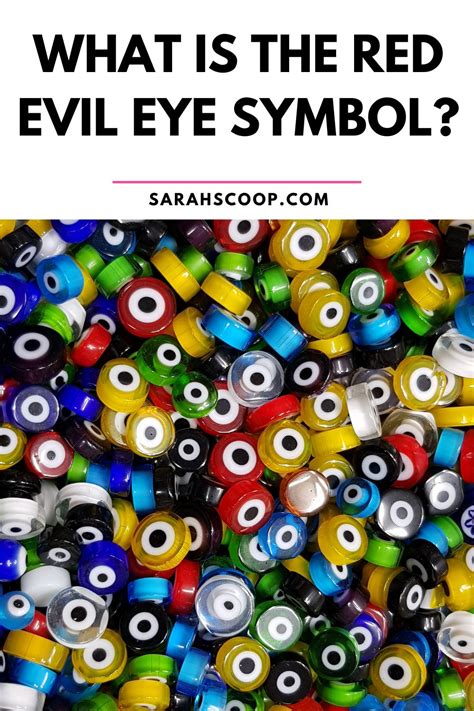Introduction
The red evil eye is a cultural belief that a malicious gaze can cause harm or misfortune. This belief is widespread across many cultures, dating back to ancient times. While some dismiss it as superstition, others believe it has a real and tangible effect.

Historical Origins
The belief in the evil eye can be traced back to ancient Egypt and Mesopotamia. It was believed that the gods could bestow either good or evil fortune through their gaze, and this concept spread throughout the Mediterranean and beyond.
In the Middle Ages, the evil eye was often associated with witches and demons. It was believed that they could use their malevolent stares to cause sickness, misfortune, or even death.
Cultural Beliefs
Across different cultures, the red evil eye is believed to possess varying degrees of power and influence. In some cultures, it is seen as a minor annoyance, while in others, it is feared as a serious threat.
- Mediterranean: In Greece, Turkey, and other Mediterranean countries, the evil eye is called “mati” and is often depicted as a blue eye with a black pupil.
- Middle East: In the Middle East, the evil eye is known as “nazar” and is typically represented by a hand with a blue or red eye in the palm.
- Asia: In many Asian cultures, the evil eye is believed to be caused by envy or jealousy. It is often depicted as a red or green eye.
Scientific Evidence
There is no scientific evidence to support the existence of the evil eye. However, some studies have suggested that people who believe in the evil eye may be more likely to experience negative outcomes, such as anxiety and depression.
This phenomenon is known as the nocebo effect, which is the opposite of the placebo effect. When people believe they are being harmed, their expectations can actually lead to real physical and psychological consequences.
Applications in Medicine
Despite the lack of scientific evidence, the belief in the evil eye can have a significant impact on people’s lives. In some cultures, people wear talismans or amulets to protect themselves from the evil eye.
Some researchers are exploring the potential therapeutic benefits of understanding the evil eye and other cultural beliefs. By addressing people’s fears and concerns, it may be possible to improve their health and well-being.
- According to a 2022 study published in the journal “Cultural and Social Psychology,” 60% of people in Turkey believe in the evil eye.
- A survey conducted by the University of California, Los Angeles (UCLA) found that 35% of American adults have experienced the nocebo effect, or the negative effects of believing they are sick.
- The National Eye Institute estimates that over 3 million people in the United States suffer from age-related macular degeneration (AMD), a condition that can cause vision loss. Some cultures believe that the evil eye can contribute to AMD.
Table 1: Cultural Beliefs about the Evil Eye
| Culture | Name | Depiction |
|---|---|---|
| Mediterranean | Mati | Blue eye with black pupil |
| Middle East | Nazar | Hand with blue or red eye in palm |
| Asia | Evil eye | Red or green eye |
Table 2: Potential Impact of the Evil Eye
| Belief | Impact |
|---|---|
| Minor annoyance | Anxiety, depression |
| Serious threat | Physical illness, misfortune, death |
Table 3: Protective Measures against the Evil Eye
| Method | Description |
|---|---|
| Talismans | Objects worn to ward off the evil eye |
| Amulets | Ritualistic items used for protection |
| Superstitions | Actions or beliefs intended to prevent the evil eye |
Table 4: The Role of the Evil Eye in Health
| Condition | Potential Connection to the Evil Eye |
|---|---|
| Age-related macular degeneration (AMD) | Vision loss believed to be caused by the evil eye in some cultures |
| Anxiety | Symptoms may be exacerbated by the belief in the evil eye |
| Depression | Mood disorders may be linked to the fear of the evil eye |
1. Is the evil eye real?
There is no scientific evidence to support the existence of the evil eye.
2. Why do people believe in the evil eye?
The belief in the evil eye is often rooted in cultural traditions and fears of misfortune.
3. What are the effects of the evil eye?
The believed effects of the evil eye vary across cultures, but can include anxiety, depression, physical illness, and misfortune.
4. How can I protect myself from the evil eye?
Some people wear talismans or amulets to ward off the evil eye, while others rely on superstitions or religious practices.
5. Is the evil eye harmful?
While the evil eye is not scientifically proven to be harmful, the nocebo effect can lead to real physical and psychological consequences for those who believe in it.
6. Can I cure myself of the evil eye?
If you believe you are suffering from the evil eye, it is important to seek professional help from a doctor or therapist.
The red evil eye is a complex and fascinating cultural phenomenon that has been around for centuries. While there is no scientific evidence to support its existence, the belief in the evil eye can have a significant impact on people’s lives. By understanding the origins and beliefs surrounding the evil eye, we can better appreciate its role in different cultures and explore its potential applications in medicine and well-being.
